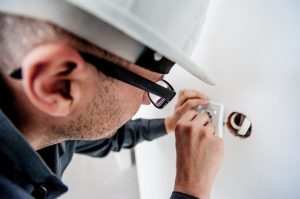A master electrician is the highest and most prominent rank one can achieve as an electrician.
With this title, you can enjoy benefits, such as:
- Entitled to higher pay and promotion
- Earn the respect of fellow tradesmen
- Demonstrate to employers and clients that you have solid, comprehensive trade experience to oversee electrical projects
In addition, master electricians are often considered leaders in the industry.
So from an apprentice to a journeyman to finally becoming a master, you will have proven that you are a valuable expert in the field.
Below, you’ll learn what a master electrician does and the license qualifications to becoming one.
Duties and Responsibilities Unique to a Master Electrician
A master electrician develops and monitors wire system installations, designs the routing of circuits, and acquires permits.
While journeymen are licensed to work independently, they aren’t allowed to pull permits or supervise other workers at the job site.
Only a master electrician can do that.
This is one of the differences between a journeyman and a master.
Other responsibilities of a master electrician include:
- Determining the cause of control and power system failures and taking the necessary corrective action
- Monitoring and evaluating equipment operation and energy efficiency
- Supervising, consulting on, and troubleshooting complex electrical equipment issues
- Overseeing other vendors and contractors and serving as their technical point of contact
- Monitoring and evaluating work productivity
- Planning and coordinating work with other trades to ensure seamless installations and minimal disruptions for all parties concerned
- Supervising and consulting on complex installations and repair projects
- Monitoring any changes in the National Electric Code and identifying training requirements for subordinates
- Supervising subordinate employees, (coaching, counseling, training, and evaluating)
- Monitoring all processes and procedures to anticipate future needs
Moreover, a master electrician has to have a thorough knowledge of the following to effectively supervise the team:
- Electrical controls and motors
- Standard practices, tools, and equipment of the electrical trade
- Safety regulations and procedures
- Interpreting diagrams, schematics, blueprints, and manuals
- Applicable county, state, and national electrical, NFPA, and safety codes
Becoming a Master Electrician: Training and Exam Requirements
After a few years of working as a journeyman electrician, you may want to pursue a higher rank and become a master.
Although each jurisdiction has varying license qualifications, most will require that you complete the following:
- About two years (4,000 hours) of journeyman experience
- Successfully pass the master electrician licensure exam
The exam will test your knowledge, skills, and ability in fields such as:
- Design of electrical systems and related equipment
- Installation, repair, and construction of such systems and equipment
- Supervision of the electrical project and the team
Some jurisdictions have different levels of master electrician licenses, which entail differing responsibilities and qualifications.
For instance, in Michigan, there are two master electrician titles.
- Electrician Master Licensed – A (advanced)
- Electrician Master Licensed – E (experienced)
Both can obtain permits and perform electrical and technical work.
However, only an EML-A can work as a team leader and supervise the work of others.
This also includes instructing and training, observing and critiquing completed work and techniques, and reviewing the job performance.
If you want to become an EML-A, then you need to have one year of EML-E experience to qualify.
This page is also available in Spanish.










